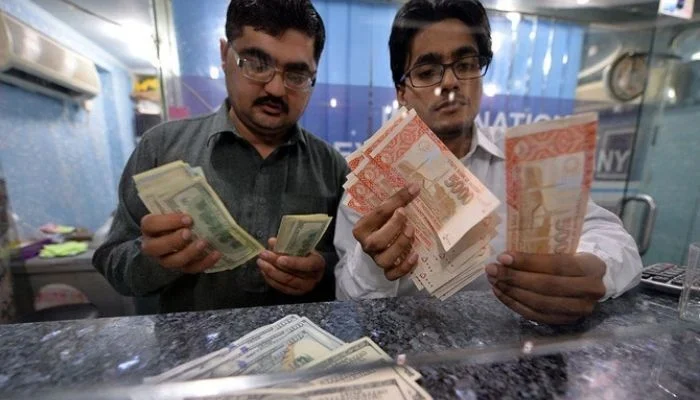The rupee declined to a record new low on Tuesday, trading against the US dollar at 222 in the open market at mid-day trade.
The quick depreciation of the local currency within a matter of a few hours drew sharp criticism from politicians and analysts expressed concern over the economic fate of the country.
Former prime minister and PTI Chairman Imran Khan said that when he was ousted via a vote of no confidence, the dollar stood at Rs178.
“Today it is Rs224 and in free fall despite IMF agreement,” he said.
“The economic meltdown shows Sharifs never had any expertise in running economy or administration. Their only expertise is looting, money laundering and getting NROs,” Khan alleged.
‘Time to stop this madness’
“It’s time to stop this madness now,” exclaimed PTI leader and former finance minister Asad Umar in a video message posted by the party’s official handle.
Umar said that Pakistan will fall so deep into an economic mess that it will become extremely difficult to pull it out if such a free fall of the rupee continues.
“For God’s sake this unnatural system made by a foreign hand must be brought to an end,” he urged, in reference to PTI’s claim that former prime minister Imran Khan’s removal through a vote of no-confidence was a “regime change conspiracy” due to what was his “independent foreign policy”.
Earlier, tweeting with his own handle, Umar remarked that “political uncertainty is bleeding the economy and inflicting tremendous pain on the people”.
“Time to stop this badly conceived, badly executed, totally gone wrong experiment. Pakistan cannot be made to suffer anymore for poor decisions,” he wrote.
‘Rupee sunk by 10 units ever since deal with IMF’
PTI leader Fawad Chaudhry, in a press conference, noted that the local currency has sunk by Rs10 “ever since an agreement was reached with the International Monetary Fund (IMF)”.
‘Killing inflation’
Journalist Mohammad Malick termed the development “untenable” and foresaw “killing inflation” ahead if the State Bank of Pakistan does not intervene and “restore sanity”.
“We need a full time SBP governor and [Minister for Finance] Miftah Ismail to refocus on this issue,” he said, adding: “Free fall of rupee guarantees economic disaster and free fall of government too.”
‘Rs10 lost in two days’
Economic journalist Shahbaz Rana drew attention to the fact that the rupee had lost Rs10 in value in just two days.
He called upon the finance minister to “no more sit idle” and let the rupee sink like this.
“SBP is without a governor for the last 75 days,” he lamented, calling it the “height of government indecisiveness”.
He warned that if the dollar’s ascent is not controlled, petrol and electricity prices will increase to “unimaginable levels”.
Rupee falls against dollar and pound
Former banker and political economist Yousuf Nazar noted at noon that the rupee has fallen to an all time low of Rs219 against the dollar and that it has also registered a decline against the pound, dropping to Rs264.
‘Are we waiting for Maryam Nawaz?’
Journalist Shahzad Iqbal in vexation wrote whether the government is waiting for Maryam Nawaz to tweet “Miftah please look into it”.
He said the country has seen no respite despite the IMF and Pakistan striking a staff level agreement and the assurance of disbursements rising to $4bn.
“Government seems to be clueless and has not appointed an SBP governor in the last three months,” Iqbal said.
100-dollar bill stashed away for grand kids
On a lighter note, Alpha Beta Core CEO Khurram Schezad tweeted a photo of a 100-dollar bill that he has preserved to give to his grand kids if he is alive by then.

 Latest News3 days ago
Latest News3 days ago
 Latest News3 days ago
Latest News3 days ago
 Latest News3 days ago
Latest News3 days ago
 Latest News3 days ago
Latest News3 days ago
 Latest News3 days ago
Latest News3 days ago
 Latest News3 days ago
Latest News3 days ago
 Latest News3 days ago
Latest News3 days ago
 Latest News3 days ago
Latest News3 days ago






















